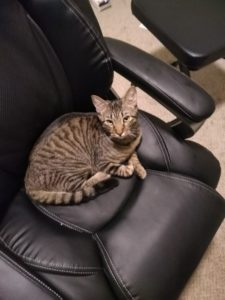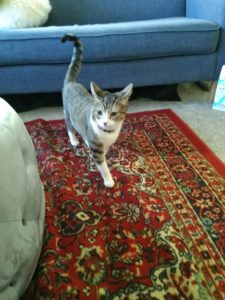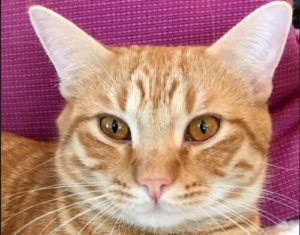Cats are very diverse in their appearance, ranging from different coat patterns, colors, and hair length, all of which is encoded in their DNA. In addition, they are also amazing pets, which I’ve gotten to experience first-hand. I adopted two kittens from the local cat café last month: Merlina and Jarvis, and they have been an absolute joy to have around, not to mention a great source of stress relief from graduate life. I noticed that their distinct coat patterns and eye colors can be attributed to their genetics, specifically, which sets of genes they each inherited from their parents. My cats are not related, but Jarvis bears more of a resemblance to Merlina than to most of Jarvis’s siblings. While I don’t know much about Merlina’s family history, Jarvis came from a litter of six kittens, many of whom have also been adopted. Despite their familial relationship, it would be hard to tell that these six cats are related just from looking at them. For example, Jarvis has at least two siblings with orange fur and red eyes, and somehow, has another sibling with bluish grey fur.



All multicellular organisms inherit one set of genes, called alleles, from each of their parents, which determines which traits of their parents they inherit (e.g., your mother’s green eyes, your father’s curly black hair, etc). Hence, each organism typically has two alleles, or copies, of each gene. We call this pair of alleles a genotype, which generally determines one’s physical attributes, or phenotype, such as blood pressure, disease risk, and so forth. If two alleles are the same, they are called homozygous, and heterozygous if they are different. One allele may be dominant to the other allele, which we call recessive, meaning that it masks the effect of the latter. In order for the trait controlled by a dominant allele to be expressed, you just need at least one copy of it from one of your parents, whereas for recessive traits, you need both copies. For example, a common coat pattern you’ll see in cats is the tabby pattern, defined by a striped coat and a distinct “M” shape on their forehead, which is the case for both Jarvis and Merlina. The reason they have this pattern is because they inherited at least one dominant allele of the Agouti gene, A, which causes the hairs to be banded. If they had two copies of the recessive allele, a, they would have had a solid color patterning all throughout their coats. Hence, their genotypes could either be AA or Aa, either homozygous or heterozygous, respectively, for the tabby phenotype in genetics terminology. Therefore, at least one of their parents had to have also been a tabby, as someone needed to pass down the A allele, making it a very common pattern to have in cats. What specific tabby pattern they have is determined by separate genes. There are four common patterns: striped (commonly referred to as mackerel, which is what Jarvis is), blotched, spotted (which describes Merlina), and ticked. Scientists have found that at least three genes work together to determine the tabby pattern, with one gene controlling stripes, and another that can break those stripes up into spots.
I mentioned that Jarvis has a brother and sister with orange fur, which tells us quite a bit about the genotype of these siblings and their parents. This fur color is due to a gene located on the X chromosome that codes for either a protein called eumelanin, which produces either a brown or black pigment, or pheomelanin, which produces a red pigment. Let’s call the dominant allele of this gene O, which codes for the red pigment, and the recessive allele o, coding for the dark pigment. One thing to note is that since the X chromosome is a sex-chromosome, females have two copies of this chromosome while males just have one. Hence, Jarvis and his brothers just have one copy of this chromosome, so they can only have one of those alleles. Therefore, Jarvis has the o allele, while his orange brother must have the O allele. Their sister, on the other hand, should have the OO genotype, since she has two X chromosomes. This is why you tend to see more male orange cats than females, as the latter need both parents to pass down the O allele. One interesting fact about this gene is that rather than Oo also producing the orange phenotype, it instead causes the cat to have patches of orange fur and dark fur, commonly referred to as the tortoiseshell pattern. Because these two distinct alleles are manifested in the phenotype, they are “co-dominant”, rather than the O allele being dominant to the recessive o, as was the case for being a tabby. This is why tortoiseshell cats are almost exclusively female (and also why it’s rare to see a female cat that’s strictly orange). In addition, the reason you see those patches in tortoiseshell and calico cats is because in female mammals, one of the X chromosomes in each cell is silenced early on in development, referred to as X chromosome inactivation, so some cells express the allele for black fur, while others express the allele for orange fur. Therefore, Jarvis’s father must have had the O allele, making him orange, while his mother had the Oo genotype. Because of her more diverse genetic makeup, Jarvis’s mother is why he and his siblings look so distinct, as she passed on her recessive o allele to Jarvis, while giving his brother and sister the dominant O. This gene can be modified by another gene that produces melanophilin, which when mutated can dilute the original coat color. If an otherwise orange cat inherits the two recessive alleles for that gene, it will have a cream colored coat instead, while a black cat will turn grey, which is why one of Jarvis’s other siblings has grey fur.
Now, I’ve shown you why Jarvis looks different from his siblings and why he has the tabby pattern, but what about Merlina? Why does she have white paws and a white underbelly? Cats with this trait, or phenotype, are called bicolor cats, meaning that they have white fur combined with some other fur color/pattern. The popular tuxedo cat, characterized by predominantly black fur, but white paws and neck, giving the appearance of a tuxedo, is an example of a bicolor cat. This coat pattern can be attributed to a gene called KIT that determines whether there will be any white in the coat. The normal allele of this is recessive and does not produce any white if a cat is homozygous for that allele (i.e., they have both copies of said allele). There are a few other variants of this gene, most notably the white spotting gene, which is what Merlina most likely has, as it prevents the migration of cells that produce melanin, called melanocytes, to certain areas of the body, causing white spots to appear instead, explaining her white underbelly and paws. It varies in expression, covering 40-60% of the body (this also distinguishes calicos from tortoiseshells). As it is a dominant allele, we can say that Merlina has at least one copy of that gene.
The genetics behind how our furry little companions get their unique and gorgeous coats is fascinating yet complex, and there are even more genes involved in other traits, such as blue fur. In addition, there still remains much to be learned about the genes that control coat color and patterning. But hopefully the next time you see a cat, you can appreciate the complex genetics that goes into making it the individual bundle of joy it is!
Peer edited by Amala John
A very interesting article Jamshaid, thank you for the information.
Thank you for this very informative article. I’ve been researching because a fellow breeder said that a pedigree of one of my cats must be faulty because it takes 2 cats with white to produce a kitten with with white. I know this is a popular misconception but difficult to find literature on Oo Ss inheritance